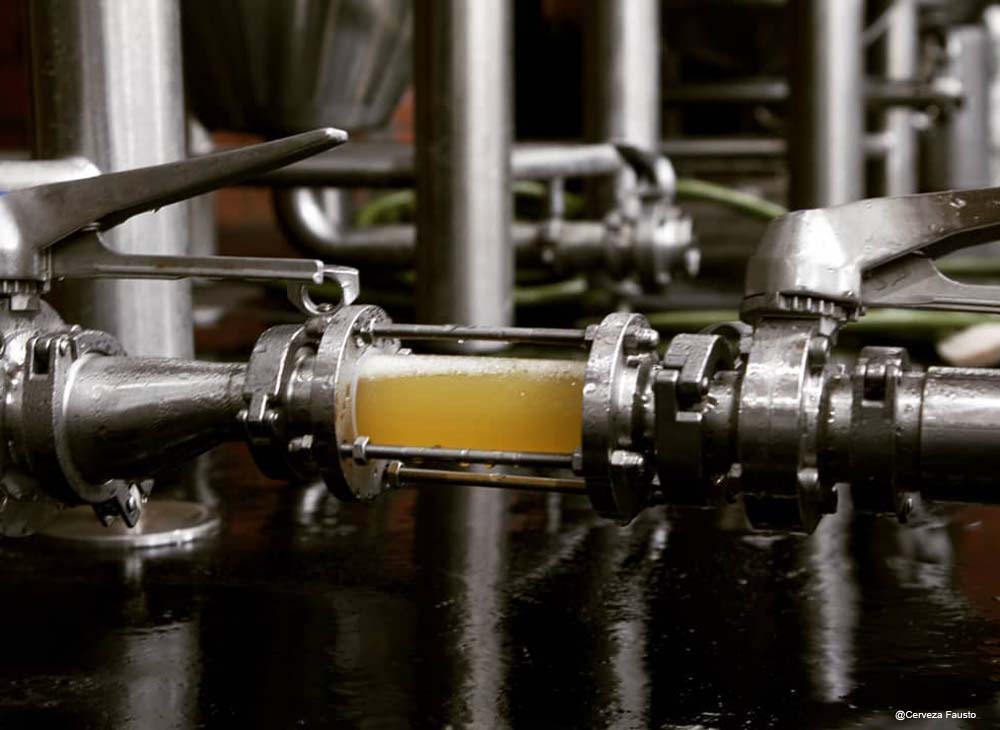How to do Sparging and Lautering with Your Beer Brewing Brewery Equipment?
- Aug 20, 2021
- 189
- tiantai
While the mash is resting, begin heating the water you will use to rinse the grain bed (the sparge water). How much sparge water will you need? We recommend heating an amount equal to the target pre-boil volume of your wort, plus about 20%. This might seem like a huge amount, but this will allow you to collect your full pre-boil kettle volume, keep the grain bed in the mash/lauter vessel submerged throughout the wort collection process and have some extra water that serves as buffer against water in the "dead spaces" (tubing, etc.) loss to evaporation or small amounts of spillage. Running out of sparge water is a pain, whereas leftover hot water can be used for cleaning equipment. So, err on the side of heating too much sparge water. For a 5-gallon (19-L) batch, this may mean 7.5 gallons (28 L) or more. If you want to try to leave your grain bed dry at the end of sparging, subtract the volume of strike water from this amount. Also, if you mash out by adding boiling water to the grain bed (see the next section), subtract this volume from the required volume of sparge water.
Your goal should be for the sparge water to be at the correct temperature when the mash is over and the wort has been recirculated. Use the length of time it took to heat the strike water to estimate how long it will take to heat the sparge water.
.jpg)
To start your continuous sparge, slowly open the valve on your mash/lauter tun and let the wort start trickling in to the kettle. If your lauter tun is not positioned above the kettle, you can let the wort flow into a pitcher and then pour wort into the kettle. Collect the wort at a rate such that takes about 60–90 minutes to collect the entire volume. To do this, keep the dip stick in the kettle and check on it every few minutes. Write down the time you start collecting wort and the time you cross the 1-gallon mark, 2-gallon mark, 3-gallon mark, etc.
The basic idea with continuous sparging is to apply water to the top of the grain bed at the same rate as it drains from the lauter tun. In theory, that should be simple. In practice it can be hard to match the flow rates. A simple way around this problem is to focus on getting the flow rate from the mash/tun to the kettle correct, then apply sparge water at a faster rate in intermittent bursts. On my old setup, I used to pour a couple pitchers of water on top of the grain bed, then, about 10 minutes later — right before the grain bed would be exposed — I'd add another two pitchers. During this time, wort would be flowing from the lauter tun to the kettle at a steady rate. Now, I do essentially the same thing by turning on and off my pump. Adding your sparge water in "pulses," rather than trying to get the flow rate to match the outflow from your mash/lauter tun is simple and lets you focus how fast your kettle is filling. Some more savy homebrewers set up a float switch, similar to those found in your toilet. The float switch will add water at the appropriate level to keep the flow from the hot liquor tank even with flow to the kettle.
You should heat your sparge water to the point that, as you sparge, the temperature of the grain bed approaches 170 °F (77 °C). If you mashed out to 170 °F (77 °C), and your lauter tun was well insulated, your sparge water should be 170 °F (77 °C) at the point that it is added. In this case, it may have to be hotter than 170 °F (77 °C) in the HLT if it travels through tubing (where it will lose temperature) on the way to your lauter tun. If your grain bed is cooler than this, then sparging with water at 190 °F (88 °C) or higher is appropriate until the grain bed reaches 170 °F (77 °C). Write down the details of your sparging in your brewing notebook.
A better way to know when to stop collecting wort is to monitor when you've gotten everything you reasonably can from the grain bed. The easiest way to do this is to take the specific gravity of your late runnings (the stream of wort you are collecting from the grain bed) and wait until they fall to about 1.008-1.010. If you do this, you may end up with more or less wort than your planned pre-boil wort volume. If you are low, as happens on many low-gravity brews, just add water. If you have collected more wort than you planned, you can extend the length of your boil. When you are done collecting wort, write down the volume of wort in your kettle, the time you quit collecting and the original gravity of the wort. Also record if you needed to add any water to reach your target pre-boil volume.
Your goal should be for the sparge water to be at the correct temperature when the mash is over and the wort has been recirculated. Use the length of time it took to heat the strike water to estimate how long it will take to heat the sparge water.
.jpg)
LAUTERING STEP 1: MASH OUT (OPTIONAL STEP)
At the end of the mash, you have the option of performing a mash out. To mash out, you raise the temperature of the grain bed to 170 °F (77 °C). Mashing out makes the wort less viscous, and easier to collect. This can be done either by applying direct heat or by stirring in boiling water. If you heat the mash, be sure to stir as you do. If you add boiling water, you will need a volume that is approximately 40% of the volume of your strike water. Sometimes, the size of your mash tun will preclude you from adding enough water to reach 170 °F (77 °C). This is fine as you can simply rinse with hotter sparge water to compensate for this. Once you arrive at 170 °F (77 °C), or have added all the water your mash/lauter tun will hold, let the grain bed rest for 5 minutes and then you are ready to recirculate. Record the details of your mash out — final temperature and volume of boiling water added (if any).LAUTERING STEP 2: RECIRCULATION (VORLAUF)
The aim of recirculation is to draw some wort off from the bottom of the grain bed and return it to the top. Once enough wort has been recirculated in this way, the wort clears up substantially. To recirculate manually, open the spigot to the mash/lauter tun slightly and slowly collect wort in a beer pitcher or similar vessel. Keep a timer running and collect wort at a rate that would fill the pitcher in about 5 minutes. Once full, gently pour the pitcher back on top of the grain bed. Repeat this until the wort looks clearer or 20 minutes have passed. Some homebrew rigs allow you to recirculate using a pump.LAUTERING STEP 3: SPARGING (WORT COLLECTION)
Once recirculation is finished, it's time to start collecting wort. In this article we cover the traditional continuous or fly-sparging technique. For a more simplified batch sparge technique, please check the following.To start your continuous sparge, slowly open the valve on your mash/lauter tun and let the wort start trickling in to the kettle. If your lauter tun is not positioned above the kettle, you can let the wort flow into a pitcher and then pour wort into the kettle. Collect the wort at a rate such that takes about 60–90 minutes to collect the entire volume. To do this, keep the dip stick in the kettle and check on it every few minutes. Write down the time you start collecting wort and the time you cross the 1-gallon mark, 2-gallon mark, 3-gallon mark, etc.
The basic idea with continuous sparging is to apply water to the top of the grain bed at the same rate as it drains from the lauter tun. In theory, that should be simple. In practice it can be hard to match the flow rates. A simple way around this problem is to focus on getting the flow rate from the mash/tun to the kettle correct, then apply sparge water at a faster rate in intermittent bursts. On my old setup, I used to pour a couple pitchers of water on top of the grain bed, then, about 10 minutes later — right before the grain bed would be exposed — I'd add another two pitchers. During this time, wort would be flowing from the lauter tun to the kettle at a steady rate. Now, I do essentially the same thing by turning on and off my pump. Adding your sparge water in "pulses," rather than trying to get the flow rate to match the outflow from your mash/lauter tun is simple and lets you focus how fast your kettle is filling. Some more savy homebrewers set up a float switch, similar to those found in your toilet. The float switch will add water at the appropriate level to keep the flow from the hot liquor tank even with flow to the kettle.
You should heat your sparge water to the point that, as you sparge, the temperature of the grain bed approaches 170 °F (77 °C). If you mashed out to 170 °F (77 °C), and your lauter tun was well insulated, your sparge water should be 170 °F (77 °C) at the point that it is added. In this case, it may have to be hotter than 170 °F (77 °C) in the HLT if it travels through tubing (where it will lose temperature) on the way to your lauter tun. If your grain bed is cooler than this, then sparging with water at 190 °F (88 °C) or higher is appropriate until the grain bed reaches 170 °F (77 °C). Write down the details of your sparging in your brewing notebook.
WHEN TO STOP SPARGING
There are a few ways to determine when to stop collecting your wort. For average-strength beers, the easiest way is just to quit collecting when you've got the full pre-boil wort volume in your kettle. With a propane burner, on homebrew-sized batches you can expect to boil off about a gallon an hour with a full rolling boil. So, for a 5-gallon (19 L) batch, you could collect 6 gallons for a one-hour boil or 6.5 gallons for a 90-minute boil.A better way to know when to stop collecting wort is to monitor when you've gotten everything you reasonably can from the grain bed. The easiest way to do this is to take the specific gravity of your late runnings (the stream of wort you are collecting from the grain bed) and wait until they fall to about 1.008-1.010. If you do this, you may end up with more or less wort than your planned pre-boil wort volume. If you are low, as happens on many low-gravity brews, just add water. If you have collected more wort than you planned, you can extend the length of your boil. When you are done collecting wort, write down the volume of wort in your kettle, the time you quit collecting and the original gravity of the wort. Also record if you needed to add any water to reach your target pre-boil volume.


.jpg)

